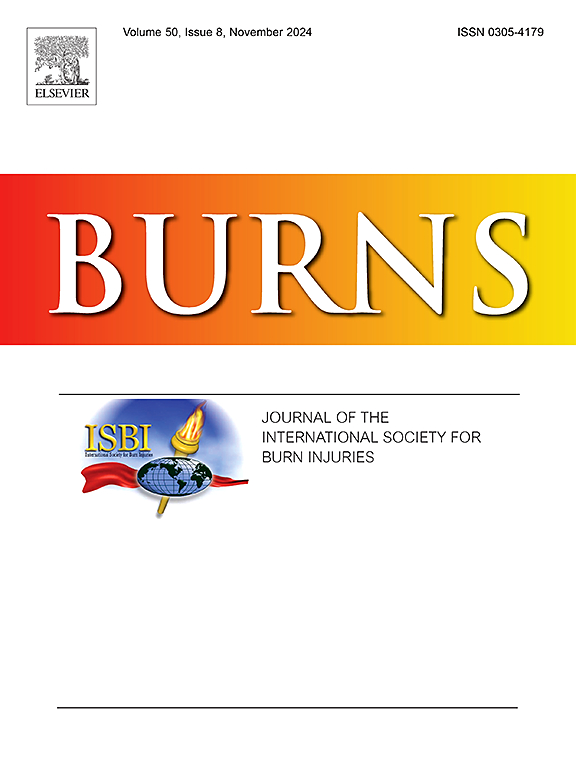评估葡萄糖酸钙浸泡治疗氢氟酸烧伤的有效性和安全性
IF 3.2
3区 医学
Q2 CRITICAL CARE MEDICINE
引用次数: 0
摘要
氢氟酸是剧毒的,与钙和镁反应时会腐蚀组织,导致严重的组织损伤。解药是葡萄糖酸钙,对治疗轻度至中度烧伤有效。然而,我们医院缺乏注册的葡萄糖酸钙凝胶,使治疗具有挑战性。由于文献很少,我们研究了替代的浸泡方法。方法回顾性分析2004年至2020年中国医科大学附属医院氢氟酸烧伤病例,重点观察葡萄糖酸钙浸泡的疗效。在我急诊科治疗的29例氢氟酸烧伤患者中,治疗包括拔甲和清创,但所有患者均接受葡萄糖酸钙浸泡,无需钙注射。结果我院急诊科共收治氢氟酸烧伤29例;8人需要住院治疗,1人住进重症监护室。烧伤在酸浓度(0.03 %-49 %)和大小(1.60 ± 2.93 %体表面积)上差异很大。治疗包括1例拔甲和4例清创。所有患者均行葡萄糖酸钙浸泡;没有人接受动脉或皮下注射。没有死亡或明显的电解质失衡。讨论葡萄糖酸钙浸泡治疗无凝胶的轻度HF烧伤是有效的。然而,缺乏对照组限制了将其疗效与其他治疗方法进行比较的能力。结论葡萄糖酸钙浸泡治疗轻度HF烧伤是一种实用的治疗方法。本文章由计算机程序翻译,如有差异,请以英文原文为准。
Assessing the efficacy and safety of calcium gluconate soaking as a treatment modality for hydrofluoric acid burns
Introduction
Hydrofluoric acid is extremely toxic and can corrode tissues while reacting with calcium and magnesium, leading to severe tissue damage. The antidote, calcium gluconate, is effective for treating mild to moderate burns. However, our hospital lacks registered calcium gluconate gel, making treatment challenging. We investigated alternative soaking methods due to scant literature on this approach.
Methods
This retrospective case series study reviews hydrofluoric acid burn cases at China Medical University Hospital from 2004 and 2020, focusing on the effectiveness of calcium gluconate soaking. Among 29 patients treated for hydrofluoric acid burns in our emergency department, treatments included nail removal and debridement, but all received calcium gluconate soaks without requiring calcium injections.
Results
In our emergency department, 29 patients with hydrofluoric acid burns were treated; 8 required hospitalization and one was admitted to the intensive care unit. Burns varied widely in acid concentration (0.03 %-49 %) and size (1.60 ± 2.93 % body surface area). Treatments included nail removal for one patient and debridement for four. All patients underwent calcium gluconate soaking; none received intra-arterial or subcutaneous injections. There were no fatalities or significant electrolyte imbalances.
Discussion
Calcium gluconate soaking is effective for treating mild HF burns in the absence of gel. However, the lack of a control group limits the ability to compare its efficacy to other treatments.
Conclusion
Calcium gluconate soaking may serve as a practical alternative for treating minor HF burns.
求助全文
通过发布文献求助,成功后即可免费获取论文全文。
去求助
来源期刊

Burns
医学-皮肤病学
CiteScore
4.50
自引率
18.50%
发文量
304
审稿时长
72 days
期刊介绍:
Burns aims to foster the exchange of information among all engaged in preventing and treating the effects of burns. The journal focuses on clinical, scientific and social aspects of these injuries and covers the prevention of the injury, the epidemiology of such injuries and all aspects of treatment including development of new techniques and technologies and verification of existing ones. Regular features include clinical and scientific papers, state of the art reviews and descriptions of burn-care in practice.
Topics covered by Burns include: the effects of smoke on man and animals, their tissues and cells; the responses to and treatment of patients and animals with chemical injuries to the skin; the biological and clinical effects of cold injuries; surgical techniques which are, or may be relevant to the treatment of burned patients during the acute or reconstructive phase following injury; well controlled laboratory studies of the effectiveness of anti-microbial agents on infection and new materials on scarring and healing; inflammatory responses to injury, effectiveness of related agents and other compounds used to modify the physiological and cellular responses to the injury; experimental studies of burns and the outcome of burn wound healing; regenerative medicine concerning the skin.
 求助内容:
求助内容: 应助结果提醒方式:
应助结果提醒方式:


